Whenever we visit Seoul, three Korean food experiences always top my to-do list – eat ganjang gejang (raw marinated raw crab), feast on Korean barbecue, and go on a Korean street food crawl in Myeongdong. We love all kinds of Korean food but those are my three favorite culinary experiences and something I need to do on every return trip to Seoul.
If you’ve been to Myeongdong, then you’re no stranger to all the delicious street food to be found there. It’s home to Korean street vendors selling all kinds of tasty street food dishes like spicy rice cakes, Korean fried chicken, Kimchi fried rice, skewered fish cakes, and more. It’s a Korean street food lover’s Shangri-La and a must when visiting Seoul.
You may have heard of popular street food dishes like tteokbokki and eumok but there’s plenty more to be discovered in Seoul and South Korea. In this article, we’ll show you twenty of our favorite Korean street foods and where you can go to try them.
KOREAN STREET FOOD QUICK LINKS
If you want to learn more about Korean cuisine when you visit South Korea, then you may be interested in joining a food tour or taking a cooking class.
TOURS & OTHER SERVICES
- Food Tours: Food and Drinking Tours in South Korea
- Cooking Classes: Cooking Classes in South Korea
- eSIM: South Korea eSIM
Save This on Pinterest!
No time to read this guide on popular Korean street foods? Click on the save button and pin it for later!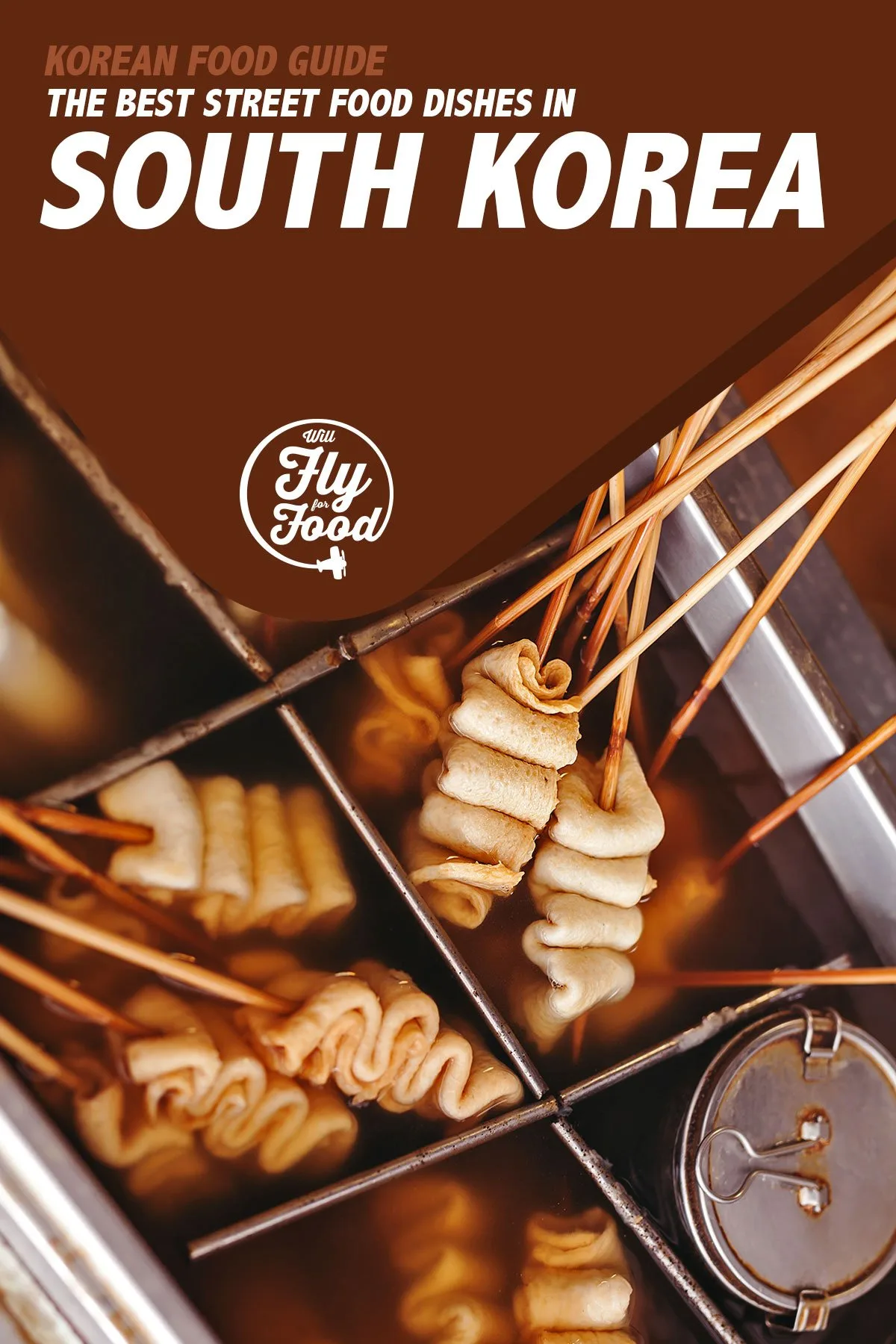
Photo by NothingIsEverything
THE BEST KOREAN STREET FOOD
THE MOST DELICIOUS KOREAN STREET FOOD DISHES
1. Tteokbokki
When it comes to popular Korean street foods, tteokbokki is the first dish that comes to mind. It refers to these small, cylindrical rice cakes coated in a spicy sauce. They can be spicy or non-spicy but the spicy version (pictured below) is the most common.
These spicy rice cakes are extremely popular in Korean cuisine. They’re enjoyed everywhere – from street food stalls to markets to pojangmachas (tented street stalls) and restaurants. Available in pre-packaged form at supermarkets and grocery stores, they’re often prepared at home as well.
My sister-in-law is Korean and a former chef and tteokbokki is one of her favorite Korean snacks. It’s one of those dishes that brings Koreans a sense of comfort, much like sandwiches for Americans or tamago kake gohan for the Japanese.
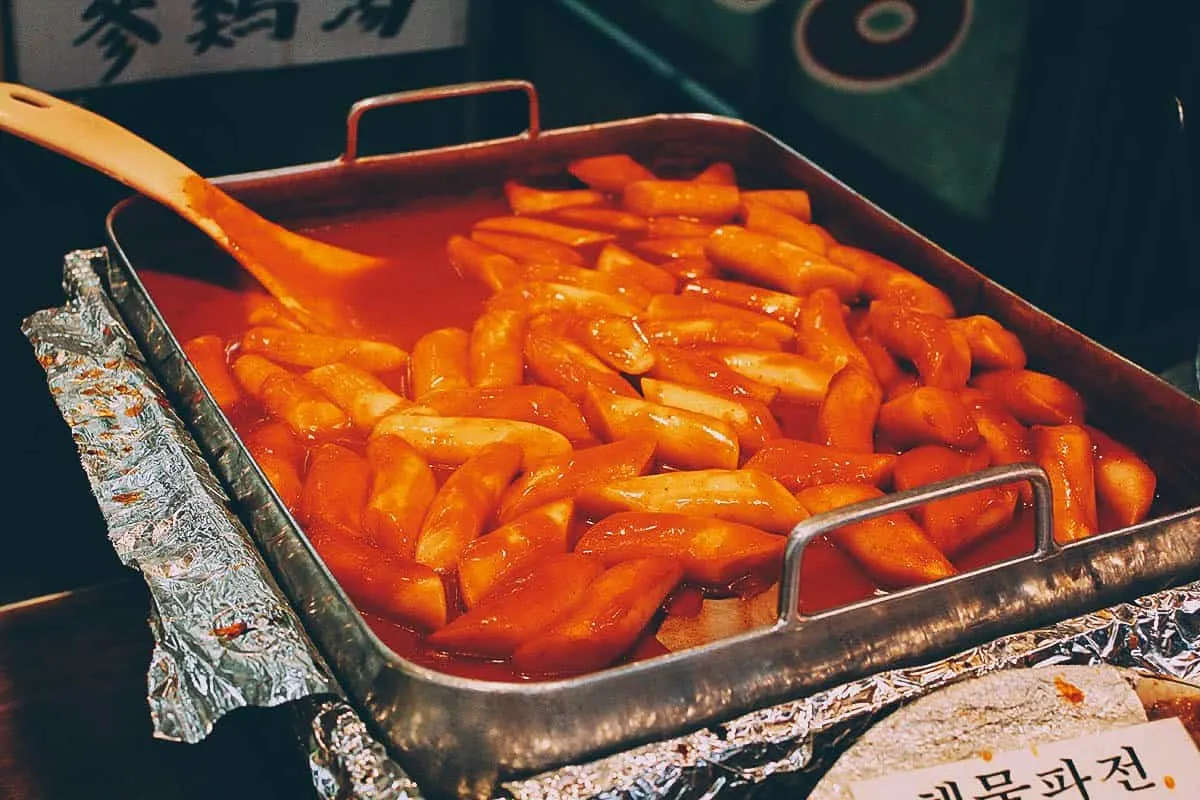
These Korean rice cakes are frequently served with spicy sauce but it’s also common to find them skewered with other ingredients like fish cakes, cheese, sausages, and scallions. When skewered, they become a type of kochi or skewered street food known as tteok-kochi.
Pictured below are fish cake, sausage, and rice cake skewers from a street food vendor in Myeongdong. You can see the rice cake wrapped inside the fish cake.
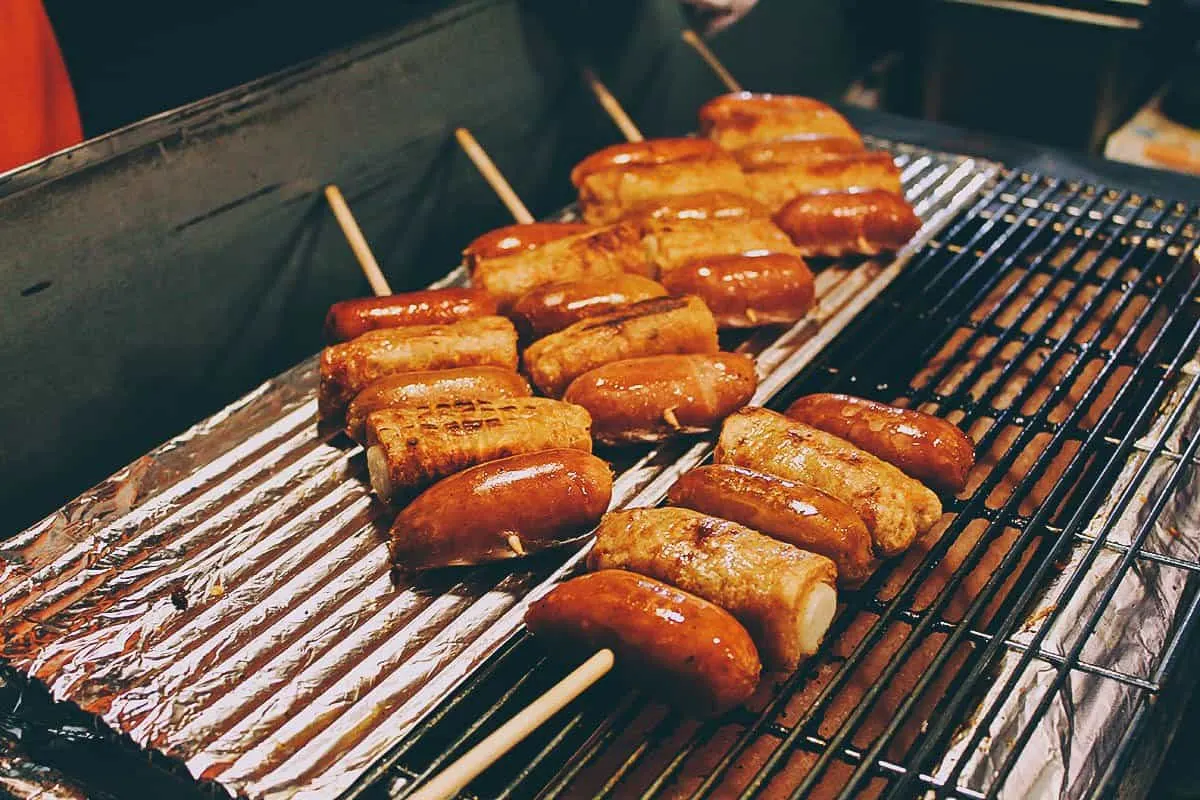
If you’d like your tteokbokki with a bit more sweetness, then perhaps you’d like to try these rice cake and mozzarella skewers. They’re rich and creamy and quite delicious.
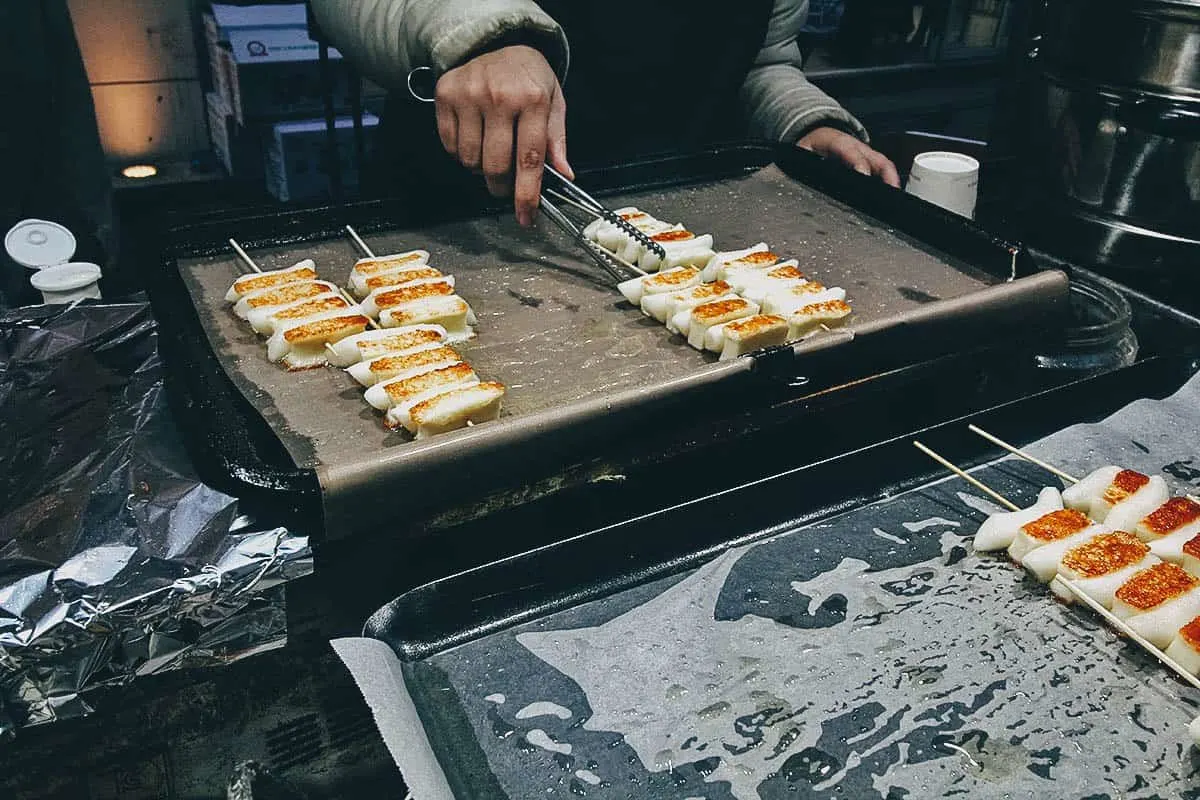
2. Eumok / Odeng
Ganjang gejang makes me weak in the knees but for Ren, the one Korean dish that she needs to have on every return trip to Seoul is eumok. Eumok (or odeng) refers to Korean fish cake. Fish cakes can be made from different types of fish but in Korea, it’s typically made from less fatty fish and seafood like corvina or cuttlefish.
Korean fish cakes come in many forms and can be served in different ways, but one of the most delicious and fun to eat is this skewered street food version boiled in broth (eumok-kkochi). Sold by street food vendors, the skewered fish cakes are served in a cup with broth for dipping and drinking.
If you visit Korea in winter, then nothing will warm you up and make you happier than a bowl of eumok in broth.
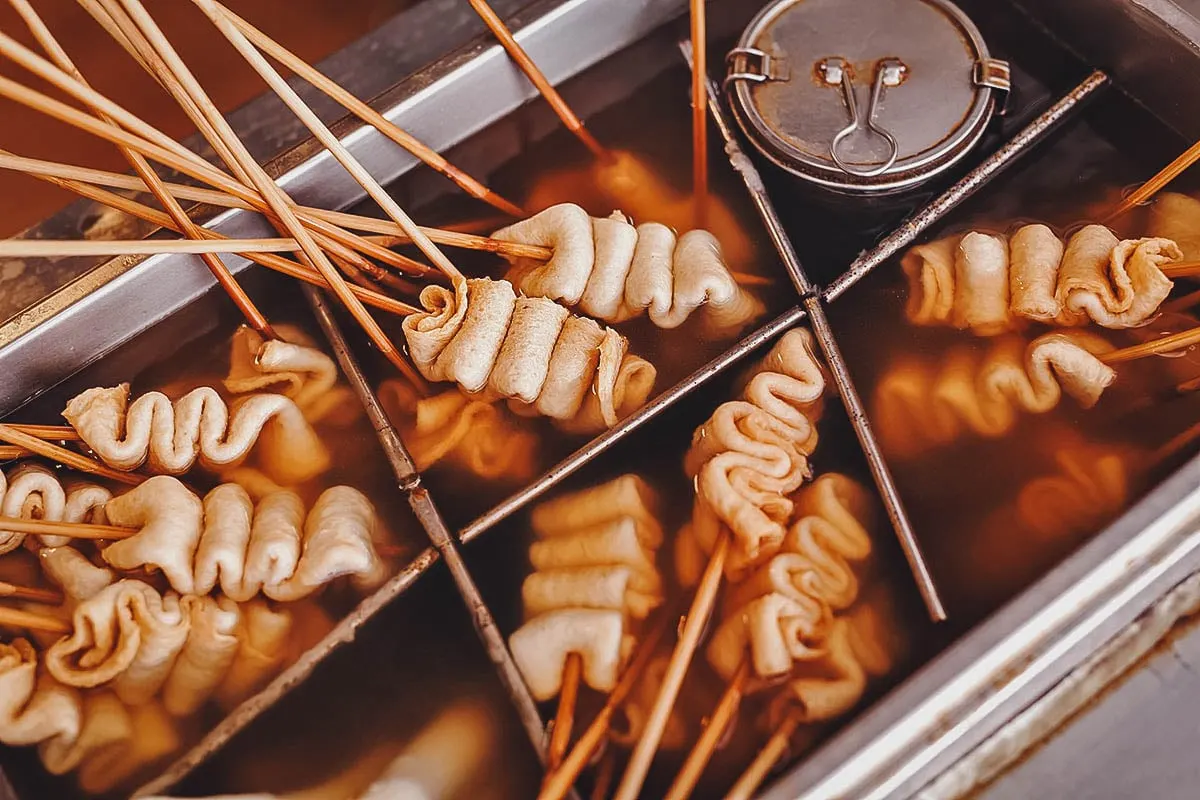
Photo by NothingIsEverything
3. Dakkochi
Like tteok-kochi and eumok-kochi, dakkochi refers to a type of skewered Korean street food, this time with chicken (dak) as its main ingredient. These supremely tasty Korean chicken skewers are made with small chunks of chicken and scallions that are threaded onto bamboo skewers before being grilled and brushed with a sauce.
Walk around popular street food areas like Myeongdong or Insadong and you’ll find many different types of kochi for sale. Dakkochi and eumok-kochi are two of the most delicious.
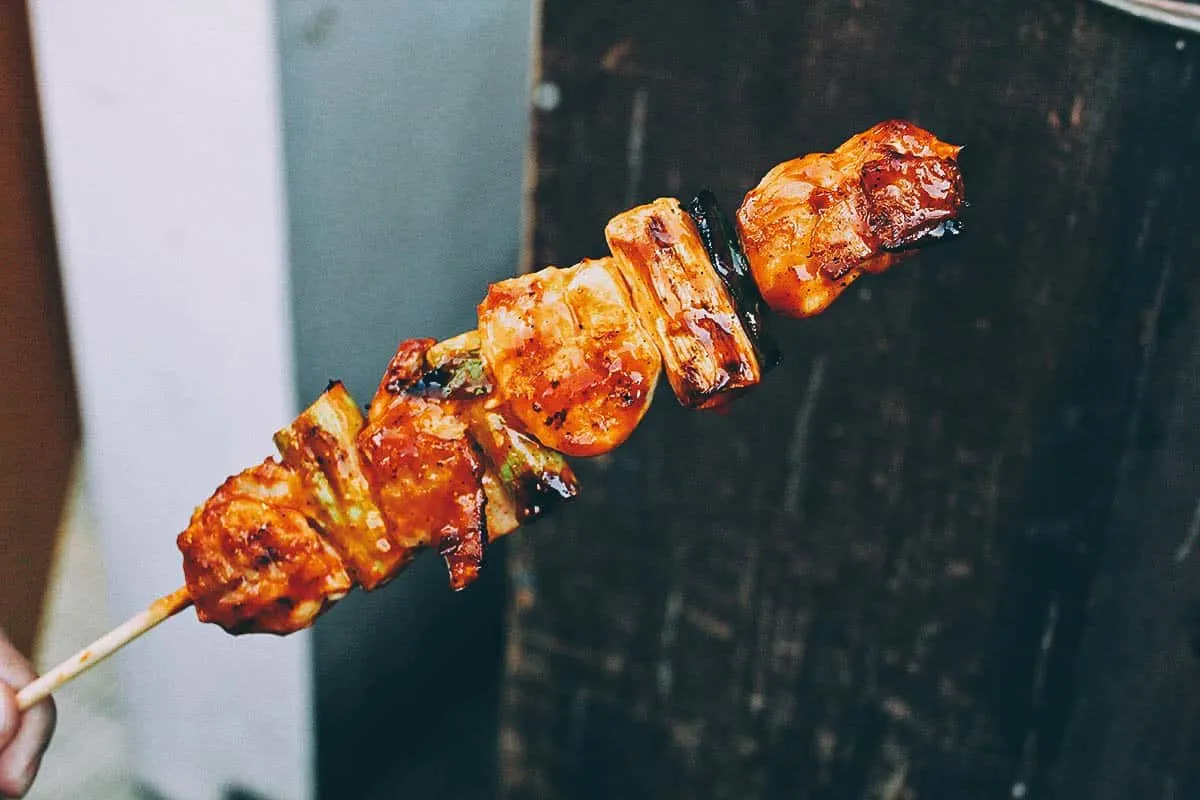
4. Bindaetteok
These mung bean pancakes are among the most common street food dishes you’ll find at Gwangjang Market. Bindaetteok is a type of buchimgae or Korean pancake made with ground mung beans, vegetables, and meat.
Like Myeongdong, Gwangjang Market is one of the best places in Seoul to enjoy Korean street food. Go to the market early in the morning and you’ll find many street vendors making these mung bean pancakes from scratch.
A popular breakfast or snack, the mung bean batter and fillings are pan-fried on both sides into round, flat shapes before being served with a dipping sauce made from soy sauce, vinegar, and ground pine nuts.
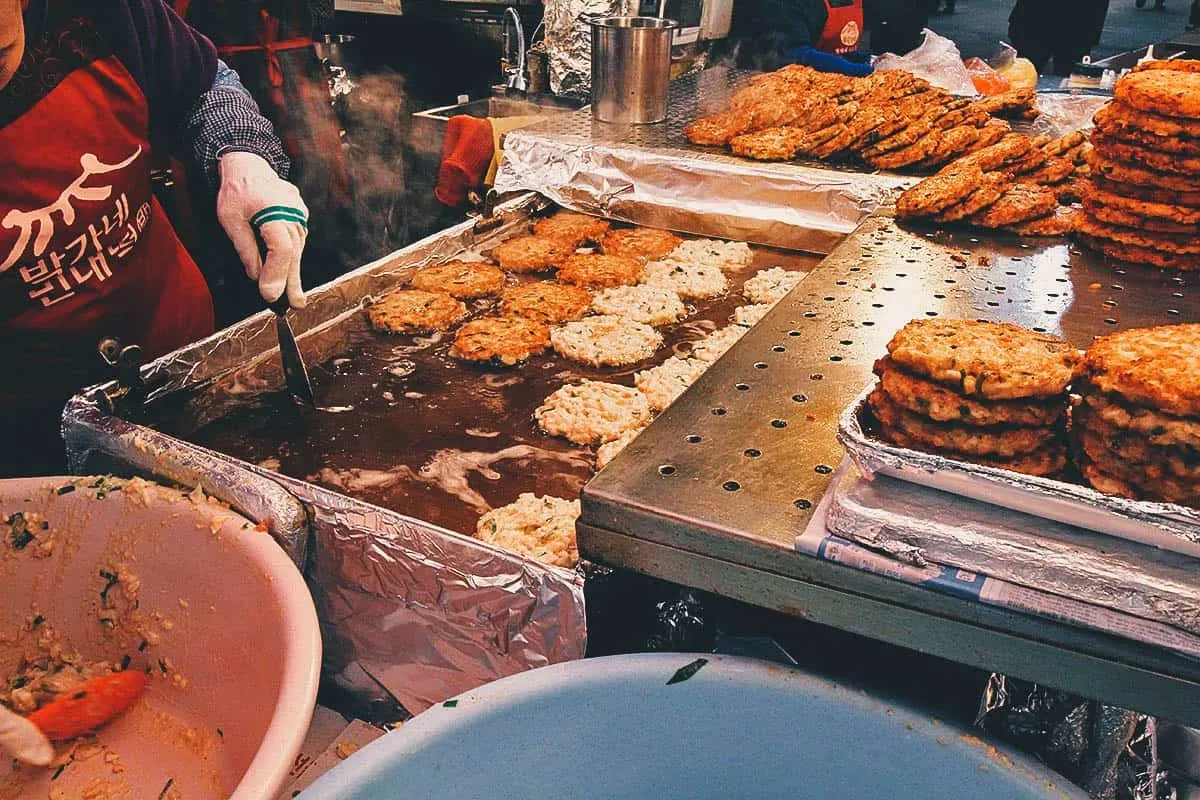
5. Hotteok
Hotteok is another popular street food in South Korea. It refers to a type of filled pancake made with yeasted wheat dough stuffed with a sweet mixture of brown sugar, honey, cinnamon, and chopped peanuts.
Cooked on a griddle, these delicious Korean sweet pancakes are a fixture at markets and popular street food areas like Myeongdong and Insadong.
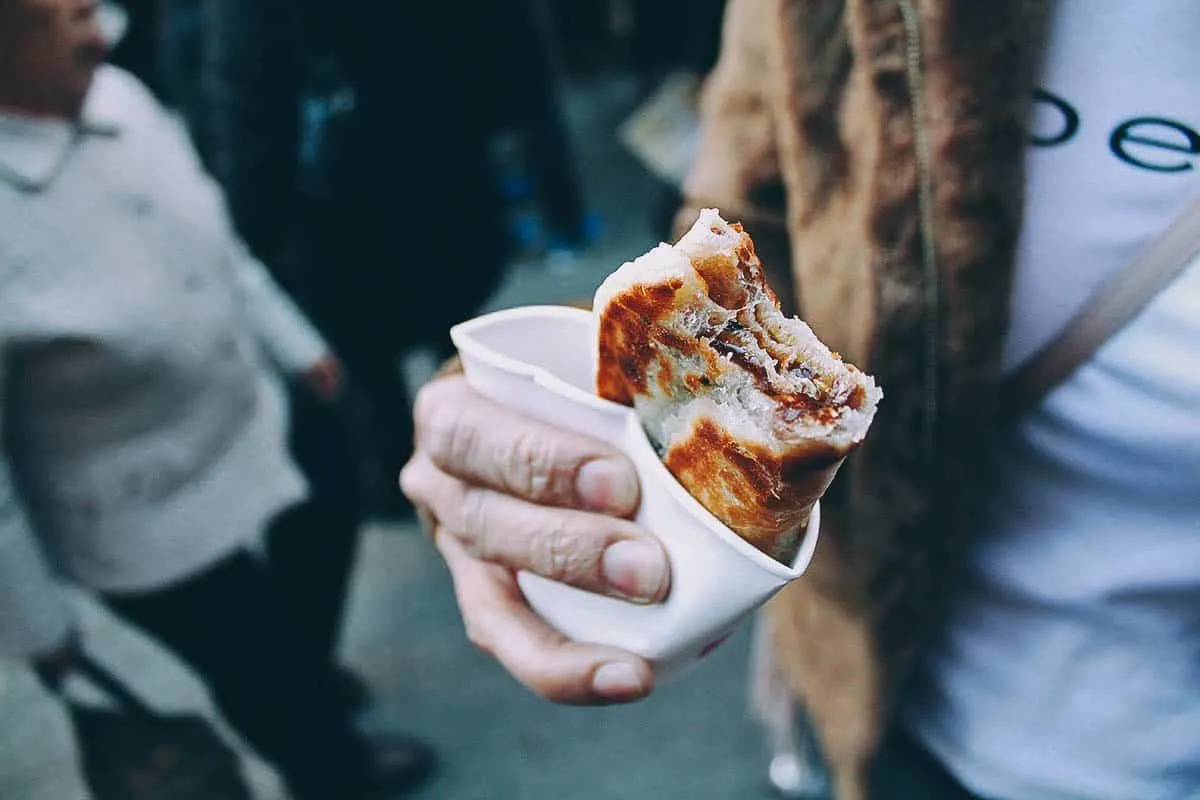
6. Mandu
If you like dumplings, then you need to try mandu. It refers to a family of Korean dumplings made with different types of meat and vegetables. They vary in shape and can be steamed, boiled, pan-fried, or deep-fried.
Available throughout the Korean Peninsula, mandu are similar to the various meat-filled dumplings that can be found in different parts of Asia like China, Japan, Mongolia, Kazakhstan, and Armenia. Their exact origins are unclear though they may have been brought to Korea from the Middle East by way of the Silk Road.
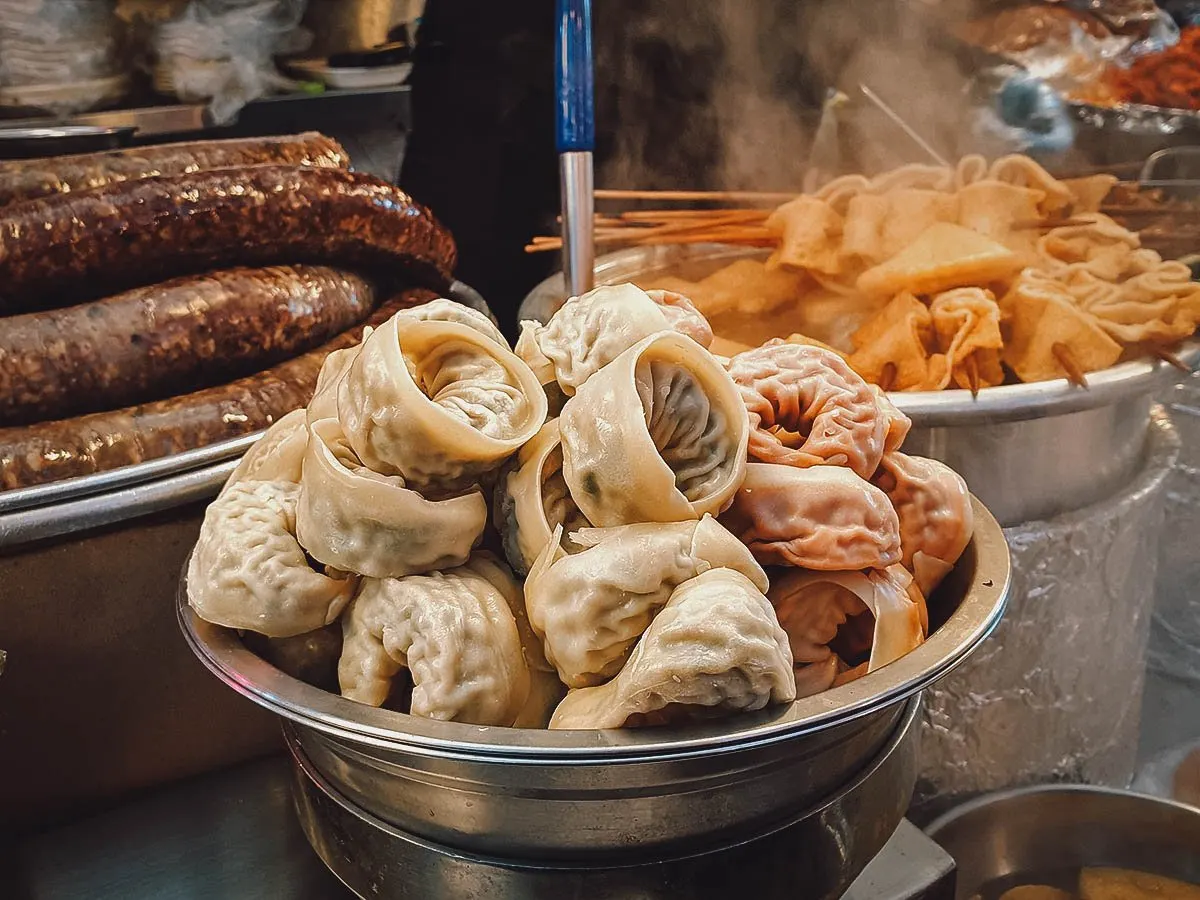
Photo by Kwan1st
7. Kimbap
Kimbap (or gimbap) looks like a big Japanese sushi roll. But unlike sushi, it isn’t made with vinegared rice. Instead, it’s made with cooked white rice rolled in seaweed with vegetables and other ingredients like meat, fish, egg, and cheese.
Before slicing kimbap rolls into more manageable bite-sized pieces, they’re often brushed with sesame oil and drizzled with sesame seeds. It’s a portable snack that’s become one of the most popular Korean street foods both in Korea and internationally.
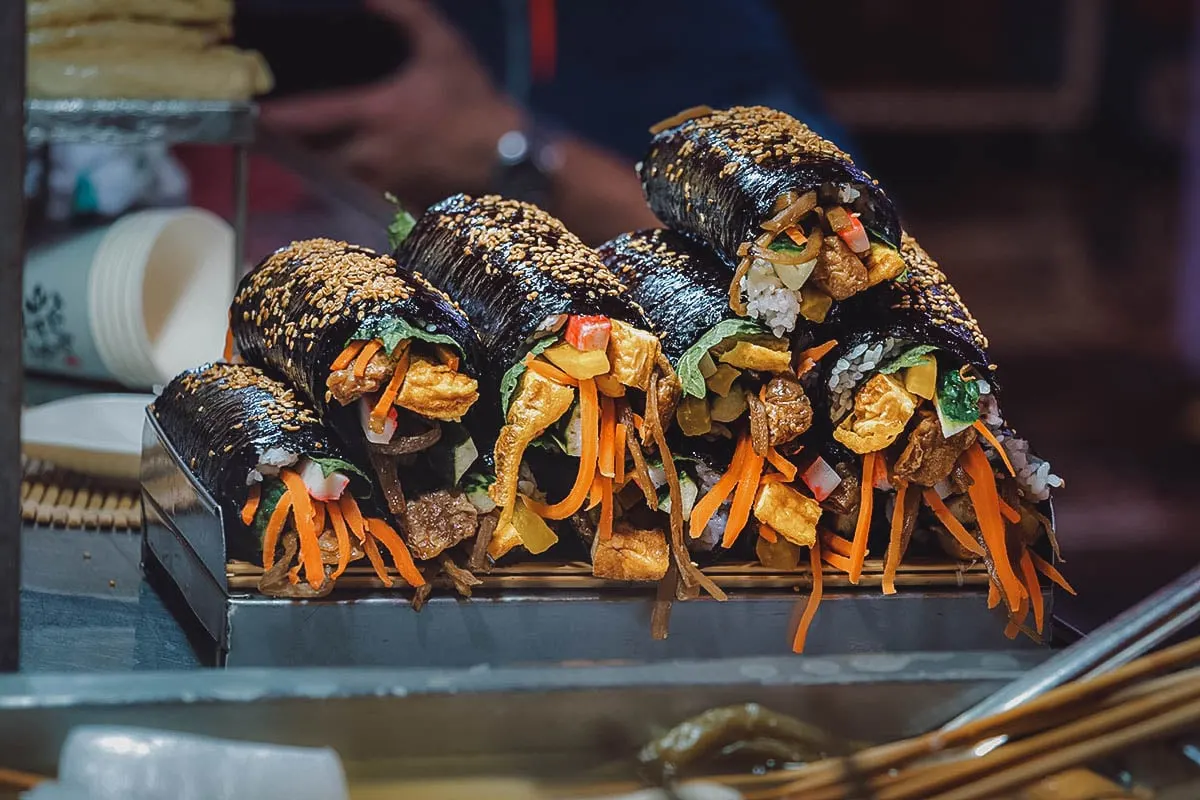
Photo by RUBEN M RAMOS
8. Twigim
If kimbap is the Korean version of sushi, then twigim is the Korean equivalent of tempura. It refers to any type of seafood, meat, poultry, or vegetable that’s been battered and then deep-fried.
Twigim is a popular street food in Korea that’s often paired with tteokbokki. Just dip them into the spicy red sauce and you’re good to go!
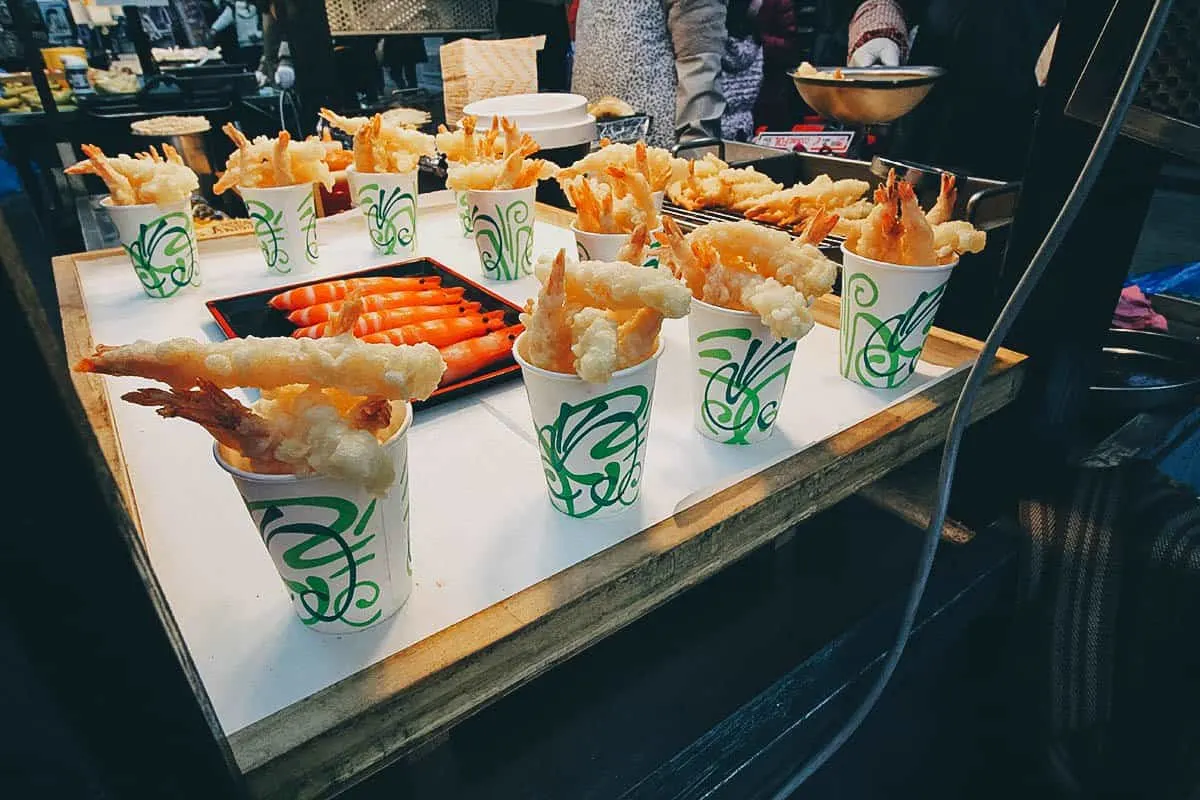
9. Gunbam
Roasted chestnuts seem to be a popular street food snack in many countries that experience cold winters. Off the top of my head, I’ve seen them sold by street vendors in Turkey, Portugal, Spain, Greece, Japan, and South Korea. You can even find them in our native Philippines around December.
In Korea, roasted chestnuts are called gunbam. Both North and South Korea are among the biggest producers of chestnuts in the world, so it’s no surprise that it’s one of the most popular Korean street food snacks in late autumn and winter.
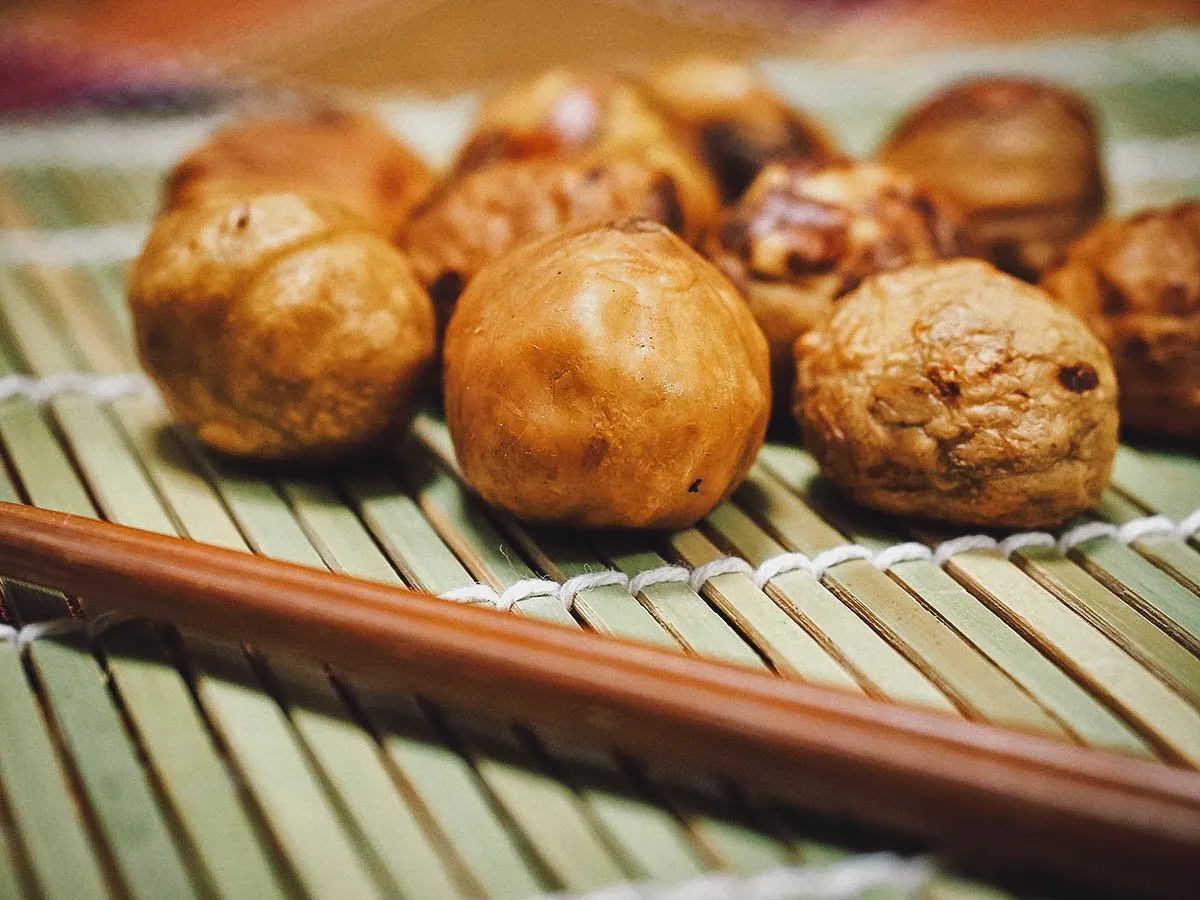
Photo by sungsu han
10. Gungoguma
Like chestnuts, roasted sweet potatoes are a popular winter street food in Japan, China, and South Korea. Known locally as gungoguma, you’ll find many street food stalls selling these purple potatoes during the fall and winter seasons in Korea.
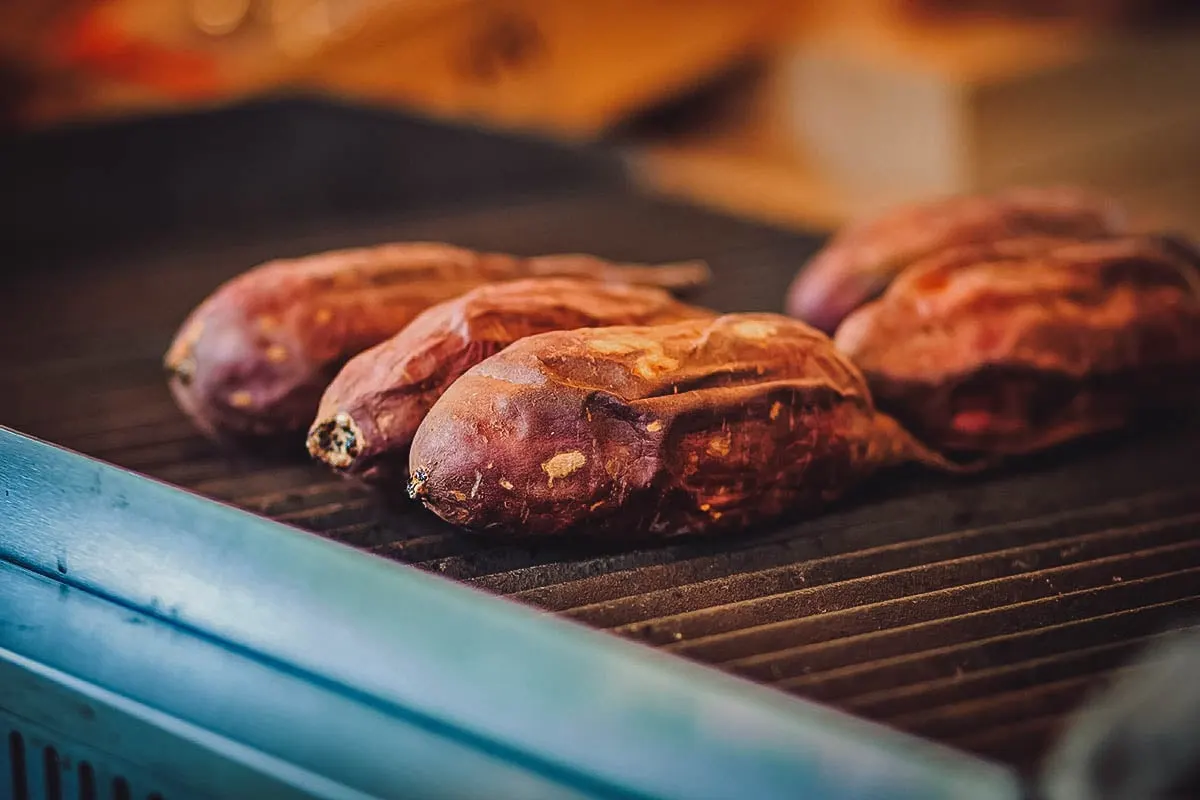
Photo by Christopher PB
11. Tornado Potato
When it comes to fun Korean street food, few dishes can top these eye-catching swirly treats of spud goodness called tornado potatoes. It’s basically a spiral-cut whole potato that’s been skewered and brushed with various seasonings like onion powder, cheese, and honey.
We’ve only had the pure potato version but some street vendors make them with a whole sausage skewered through the middle of the spud tornado.
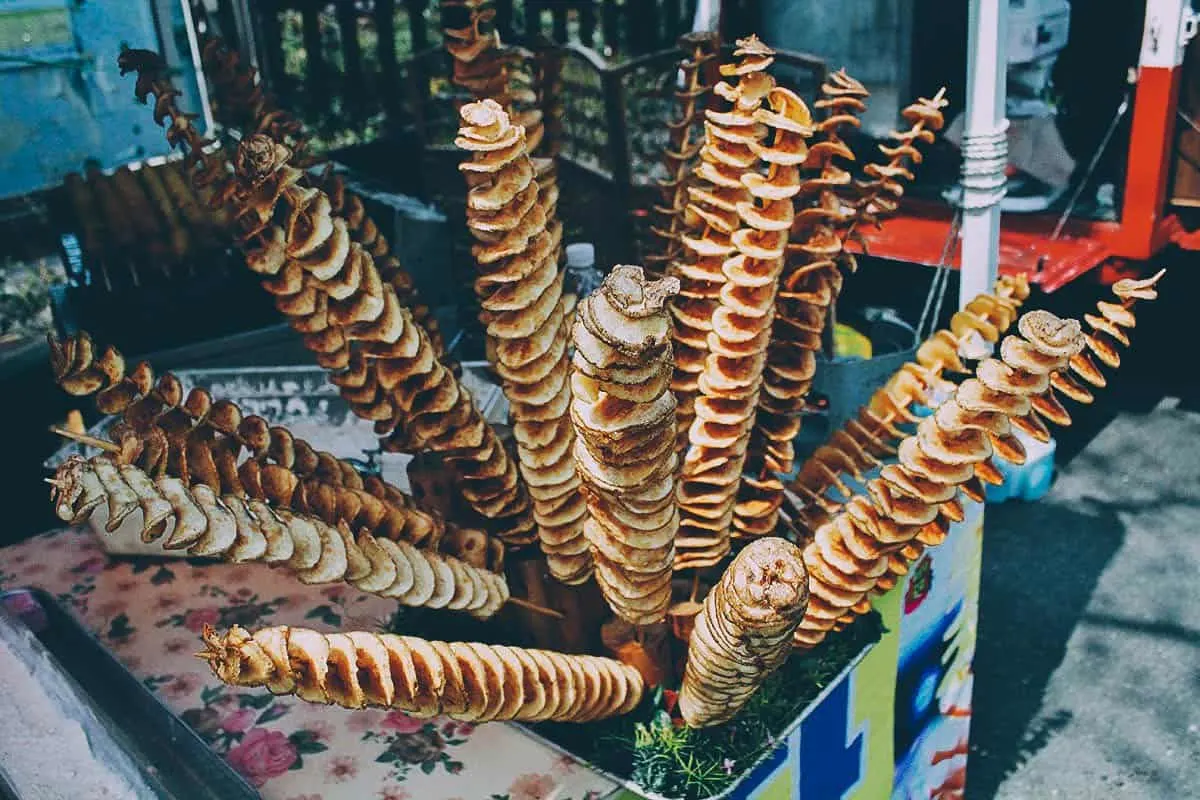
12. Gamja Hot Dog (Tokkebi Hot Dog)
Gamja hot dog refers to another fun Korean street food that’s hard to resist. Also known as a tokkebi hot dog, it looks similar to an American corn dog except it’s coated in a batter with french fries instead of the usual cornmeal batter.
Crunchy on the outside but juicy and meaty on the inside, these Korean corn dogs are fun to eat and a surefire hit with street food lovers of all ages.
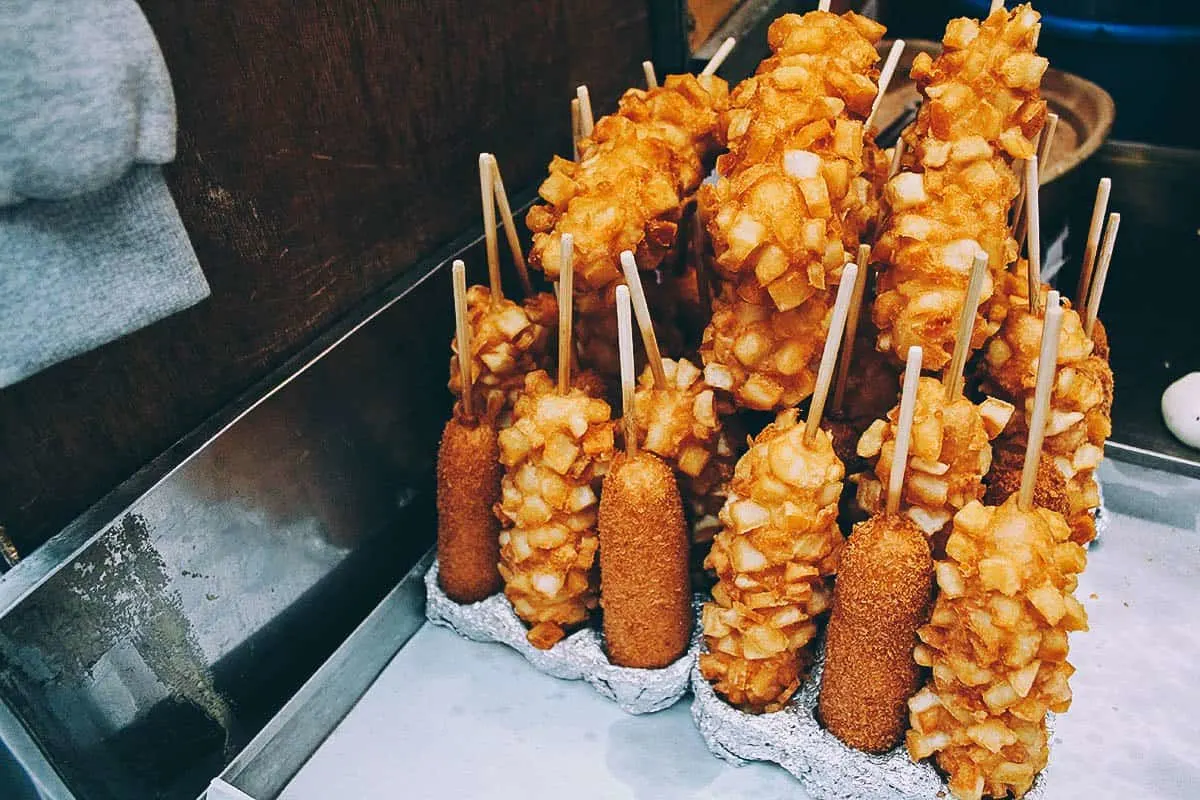
13. Soondae
If you’re a fan of blood sausages, then you need to try soondae (or sundae). It refers to an interesting type of Korean blood sausage made with a mixture of pork blood, glutinous rice, and glass noodles stuffed in cow or pig intestines.
Personally, I like soondae best when it’s served in a soup (soondae-guk) but it makes for a tasty snack as well. When eaten on its own, it’s typically served with a sauce or condiment like soy sauce, gochujang, or a salt and black pepper mixture.
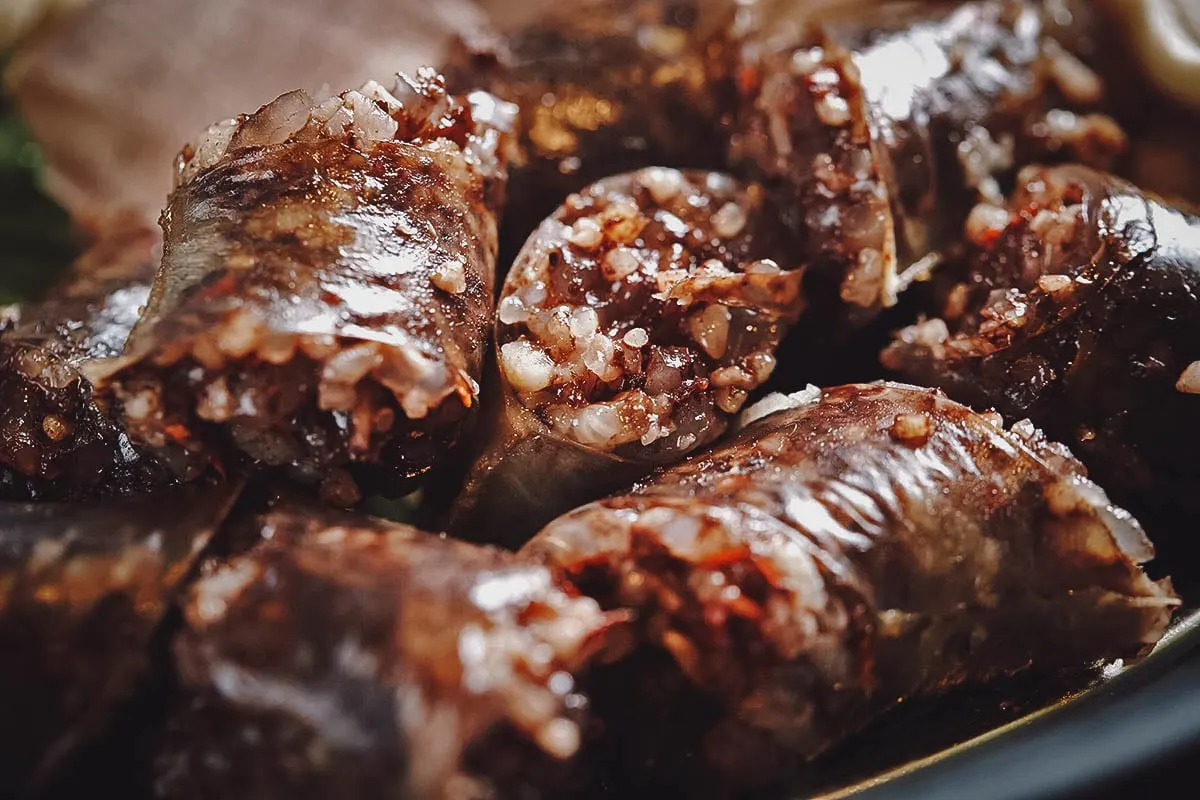
Photo by mnimage
14. Dakgangjeong (Korean Fried Chicken)
KFC is one of the most delicious chicken dishes in the world. And by “KFC”, I mean Korean fried chicken, not the American version popularized by Colonel Sanders. As much as I love Kentucky Fried Chicken, the Korean version may be even better.
Known locally as dakgangjeong, KFC refers to a supremely crunchy Korean chicken dish made with battered and double-fried chicken coated in a sweet and spicy sauce. The pieces of chicken are double-fried to help them keep their crunchy texture after they’ve been doused in sauce.
Thanks to global chains like Bonchon, Korean fried chicken has become one of the most famous Korean dishes outside of the country. In Korea, they’re often paired with beer and collectively called chimaek. The chi refers to “chicken” while maek is short for “maekju”, the Korean word for beer.
If I were to add a fourth dish to my holy trinity of Korean food experiences, then chimaek would definitely be it. Check out our Seoul restaurant guide for suggestions on where to try this perfect pairing in Seoul.
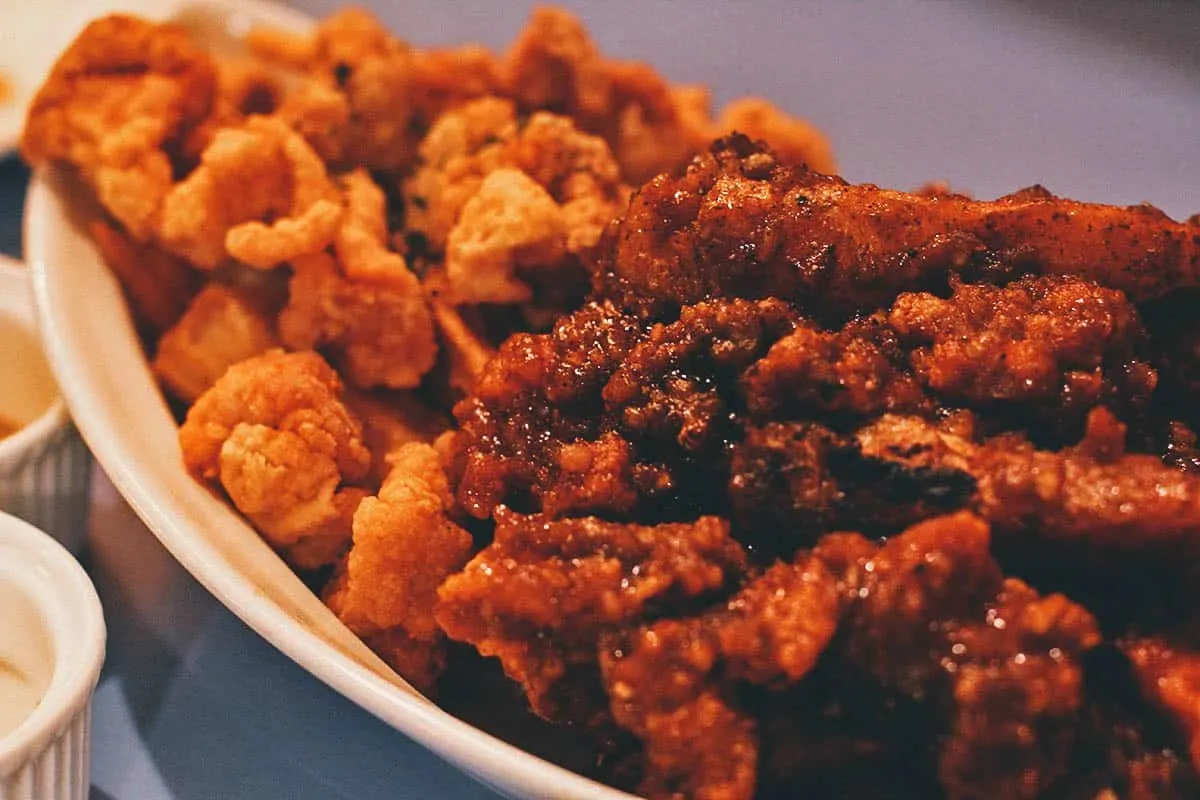
15. Lobster Tails
If you’ve done a street food crawl in Myeongdong, then you’ve probably had one of these lobster tails. It isn’t cheap but how can you resist?!
One of the most decadent Korean street foods, lobster tail meat is cut into chunks and blowtorched before being topped with grated cheese. The cheese is then melted under a Zaigle (infrared grill) before being doused in a spicy Korean sauce.
Anyone who thinks that street food can’t be luxurious needs to make their way to Myeongdong pronto.
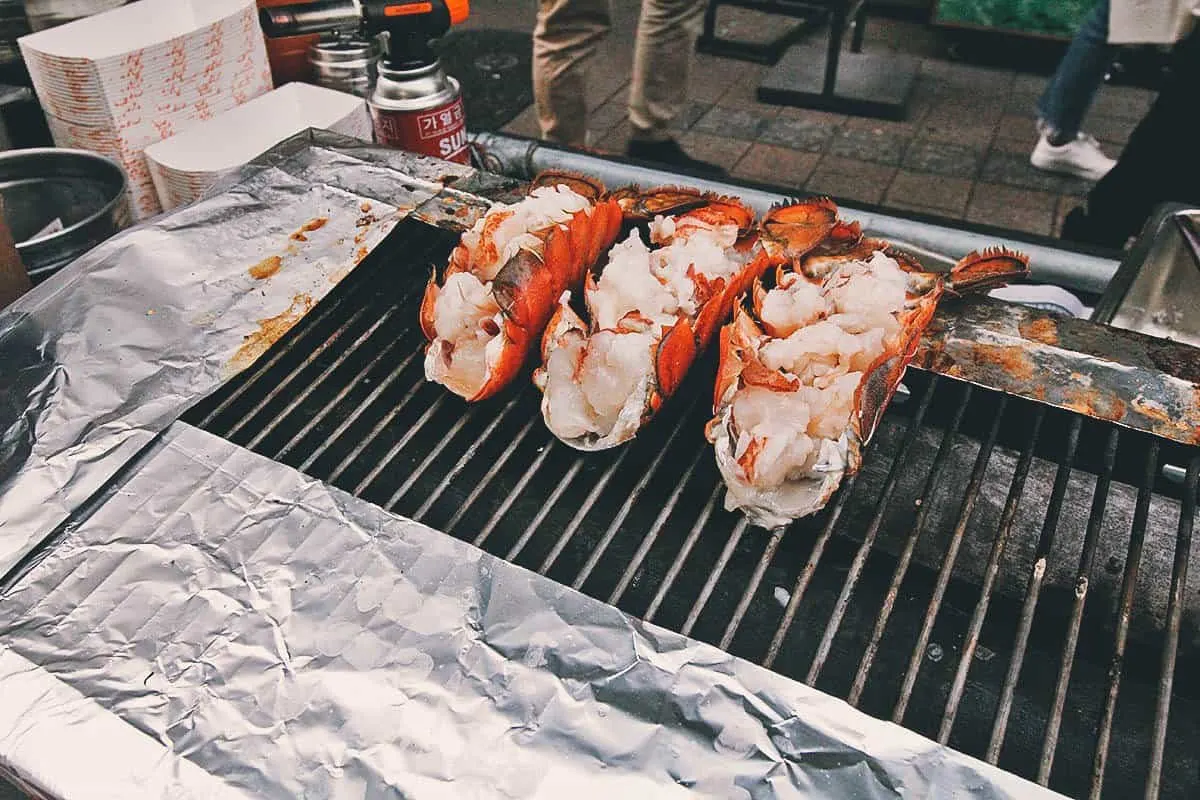
16. Gyeranppang
I’m not as crazy about sweet street food but I do love gyeranppang. These fluffy golden brown ovals of pancake dough are each made with a whole egg, hence the name gyeranppang, which literally means “egg bread”.
Korean egg bread is made in a pan with multiple oval indentations, similar to a Japanese takoyaki pan. Pancake batter is poured into these slots, followed by a whole egg, and then cooked to a beautiful golden brown.
Gyeranppang can be topped with other ingredients like cheese and diced ham but for me, the egg bread is perfect as is. Warm and sunny, they reminded me of Filipino bibingka.
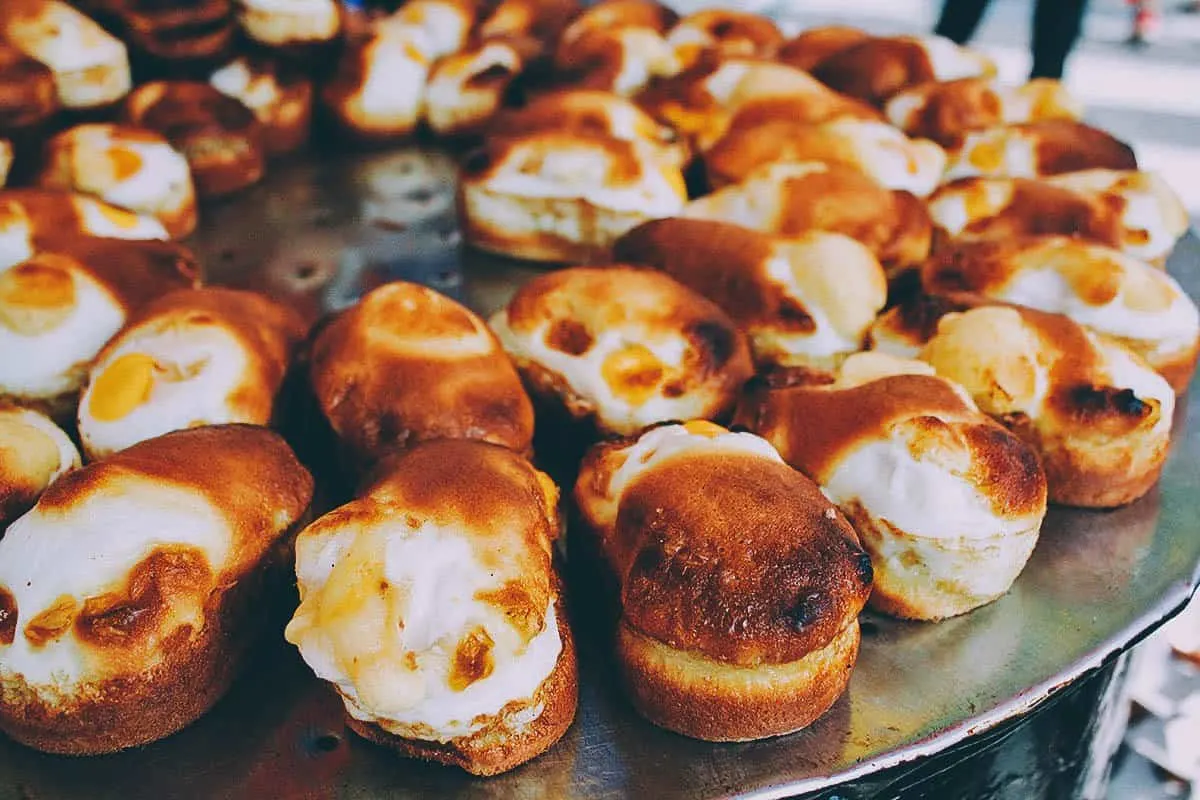
17. Jjinppang/Hoppang
Jjinppang refers to Korean steamed buns filled with red bean paste. A popular snack or dessert in Korea, they’re made of sourdough fermented with makgeolli (Korean alcoholic beverage) yeast.
If you go to convenience stores in Korea, then you can find non-fermented versions call hoppang. They’re filled with a similarly sweet red bean paste, except the paste in hoppang is passed through a sieve to make it smoother.
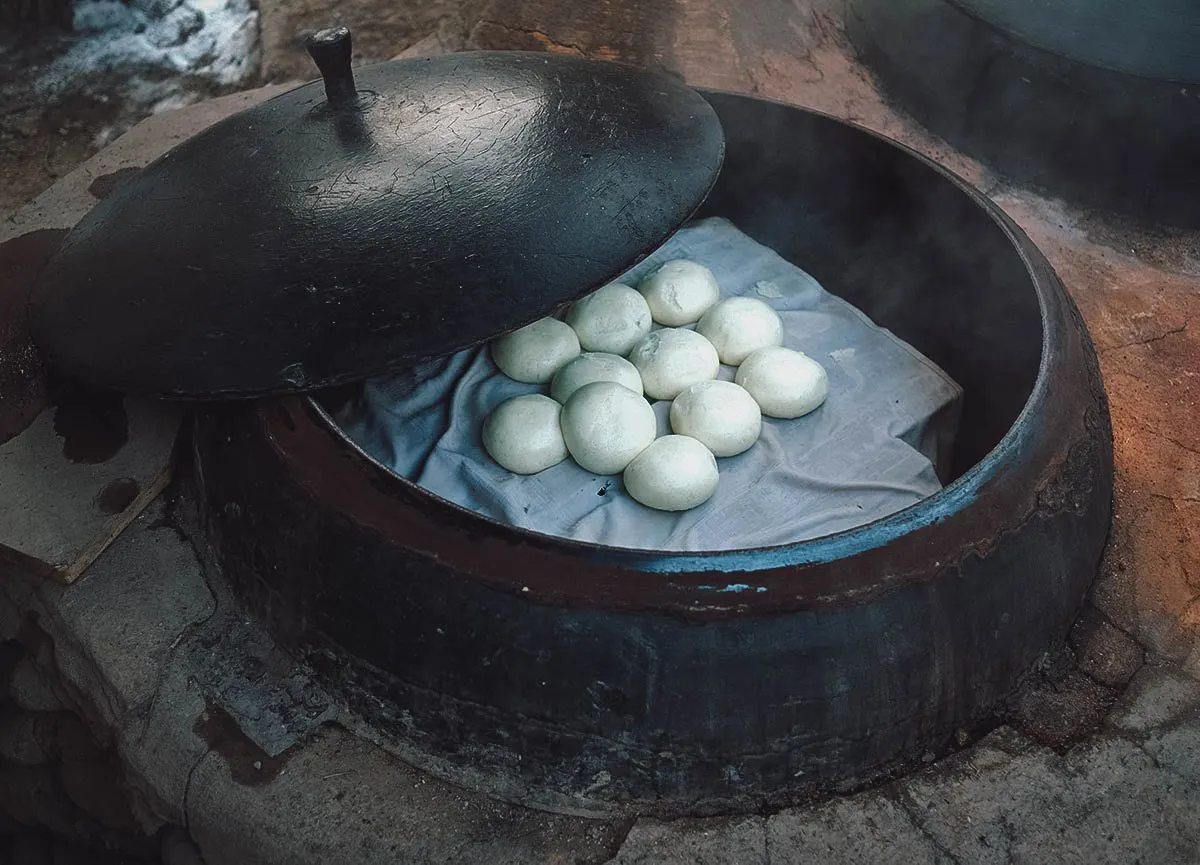
Photo by Stock for you
18. Gukhwa-Ppang
Gukhwa-ppang literally means “chrysanthemum bread” and refers to these pretty, flower-shaped pastries filled with sweet red bean paste. Like gyeranppang, they’re made in indented pans with flower-shaped molds.
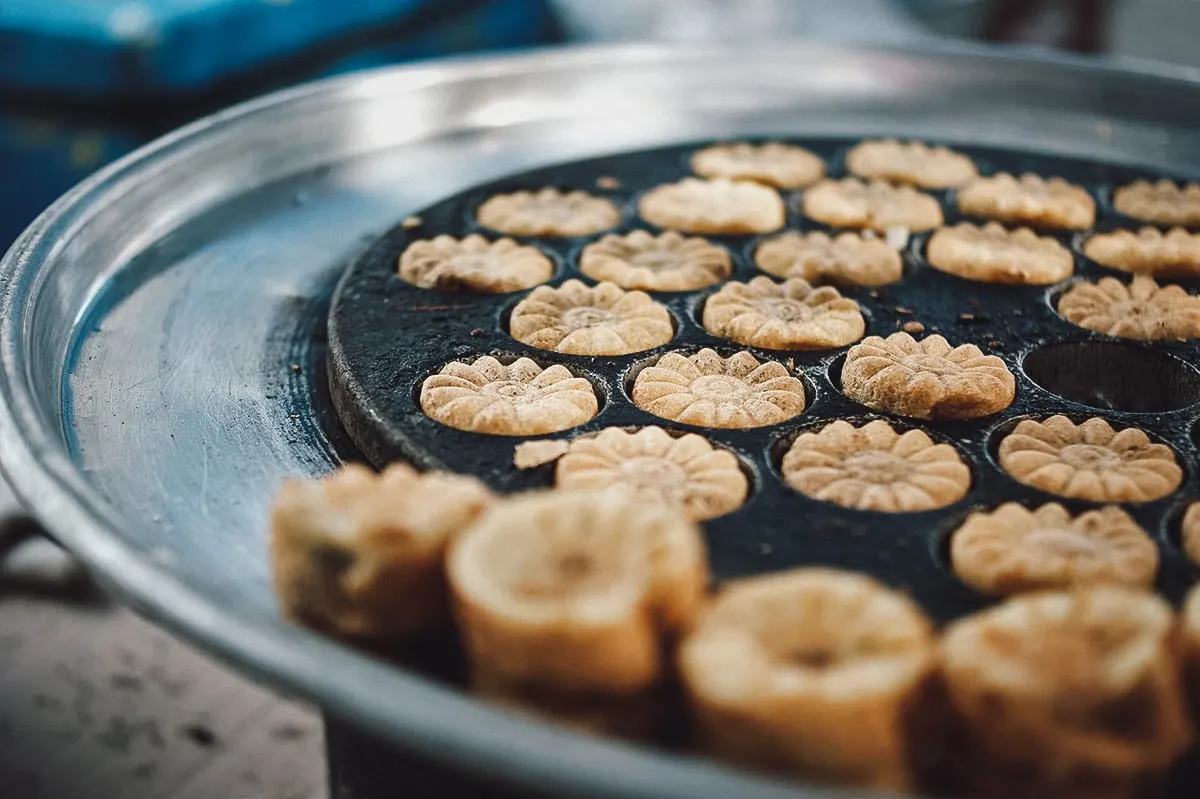
Photo by hyeri.h
19. Bungeo-Ppang
If you’re a fan of Japanese taiyaki, then you’ll definitely enjoy bungeo-ppang. It refers to the Korean version of the popular Japanese street food.
This Korean fish-shaped pastry is traditionally filled with sweet red bean paste but nowadays, you’ll find versions made with a variety of fun fillings like pastry cream, chocolate, and Nutella. You can even get savory versions filled with ham, cheese, and tomato sauce.
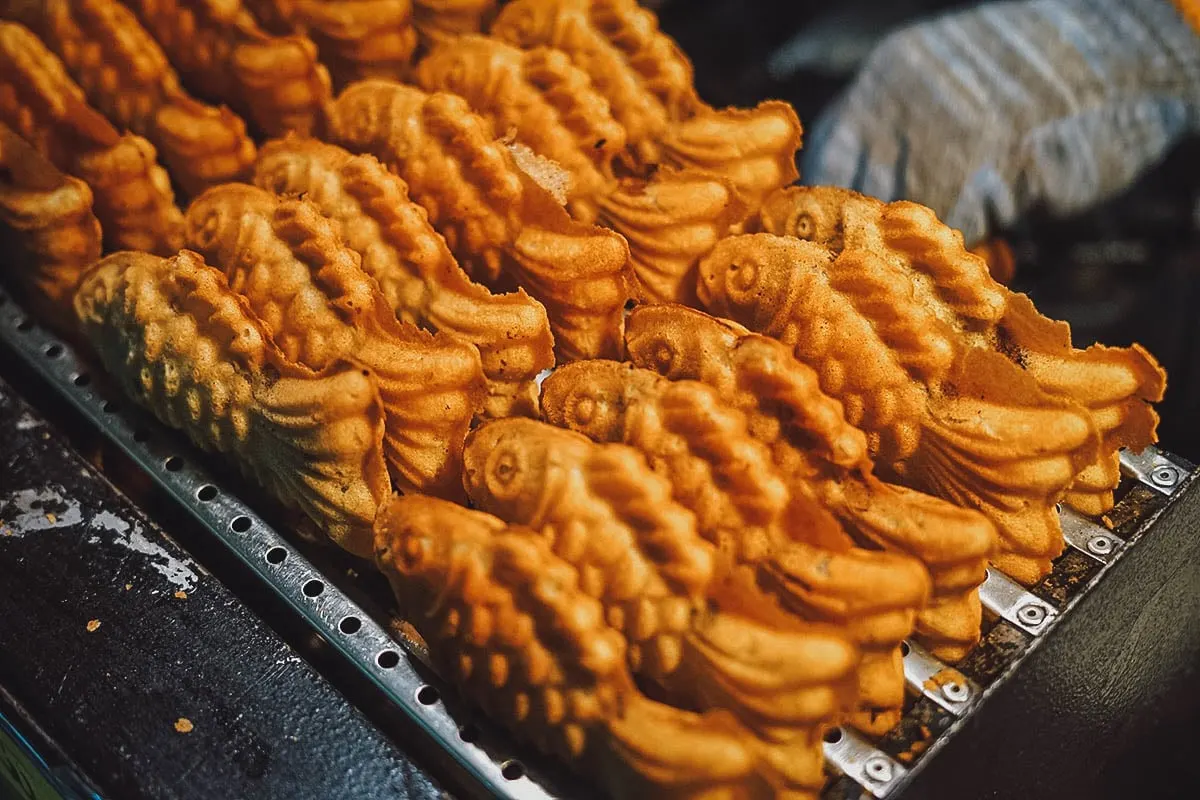
Photo by Izlan Somai
20. Kkwabaegi
Last on this list but definitely not least, especially if you like doughnuts, is kkwabaegi. It refers to a Korean twisted doughnut made from yeasted wheat flour or glutinous rice flour.
Kkwabaegi doughnuts are enriched with butter and deep-fried to a golden brown before being coated in sugar or cinnamon powder.
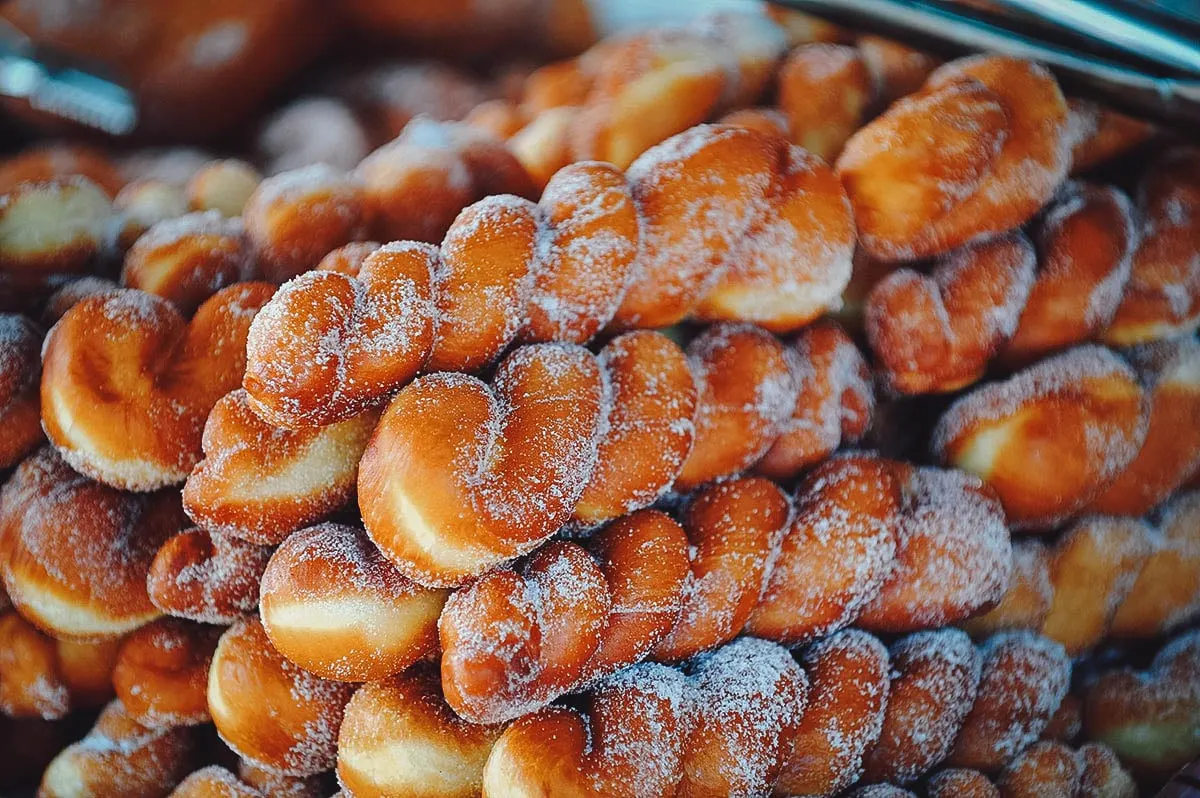
Photo by Yeongsik Im
POPULAR PLACES FOR STREET FOOD VENDORS IN SOUTH KOREA
Street food is widely available throughout South Korea. Listed below are some of the most well-known clusters of Korean street vendors selling many of the dishes featured in this article.
SEOUL
1. Myeongdong
Myeongdong is one of the most famous areas in Seoul to have street food. It’s a bustling commercial area famous for its many cosmetics shops, restaurants, cafes, and boutiques. It’s one of the liveliest districts in Seoul and a great place to have a Korean street food feast.
Myeongdong is fun at any time of the day but it’s especially lively at night, when street vendors set up their stalls and offer a wide range of Korean street food dishes like eumok, tteokbokki, Korean fried chicken, twigim, and egg bread. If you had time to visit just one area for street food in Seoul, then it should definitely be Myeongdong.
Head to the area anytime after 5-6PM for the widest selection. Most street food stalls should be set up by then.
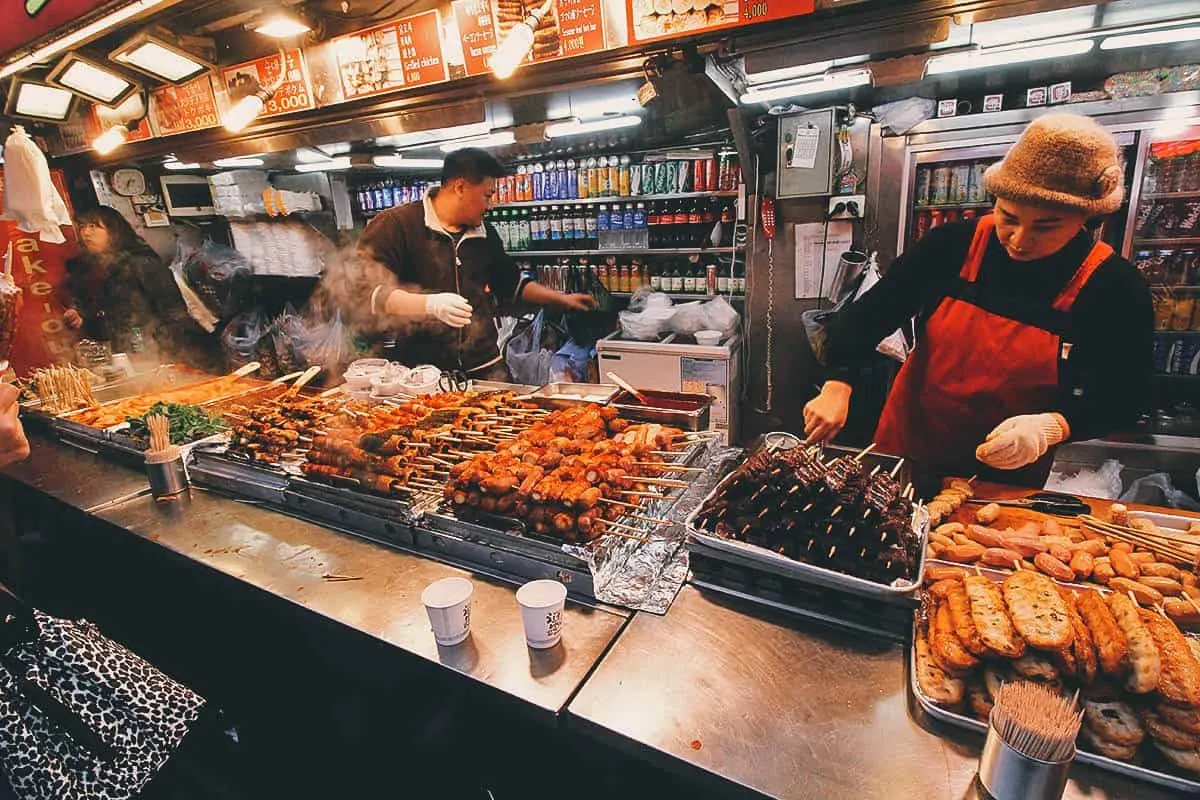
2. Hongdae
Hongdae is one of our favorite neighborhoods in Seoul. It’s short for Hongik Daehakgyo and refers to the area around Hongik University, one of the leading fine arts colleges in South Korea. It’s a fun and lively area that feels very much like a US college town.
When I asked my Korean sister-in-law for Seoul food recommendations, she recommended Hongdae for their pojangmacha. Pojangmacha means “covered wagon” in Korean and refers to these tented food stalls that offer Korean street food and alcoholic beverages at night. If you watch a lot of K-Dramas, then you’re probably already familiar with them.
According to my sister-in-law, the pojangmacha tradition is dying in South Korea but you can still find a few of them in Hongdae.
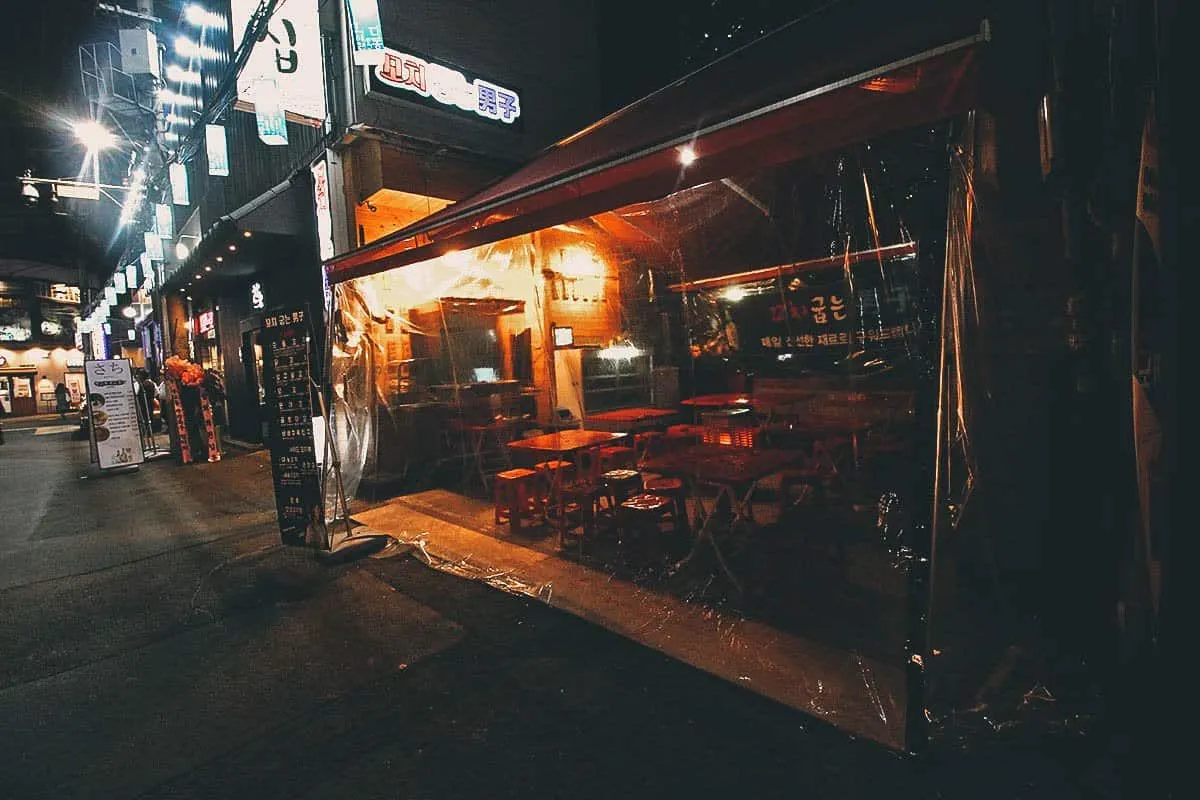
3. Insadong
Insadong is known as the cultural shopping area of Seoul. It’s home to almost half of South Korea’s antique shops and art galleries. With its many artisan boutiques and street food carts, it’s a great place to buy cultural souvenirs while feasting on Korean street food.
Though not quite as abundant as Myeongdong, you can still find many types of Korean street food in Insadong. Check out my article on Myeongdong, Insadong, and Hongdae for more pictures and information.
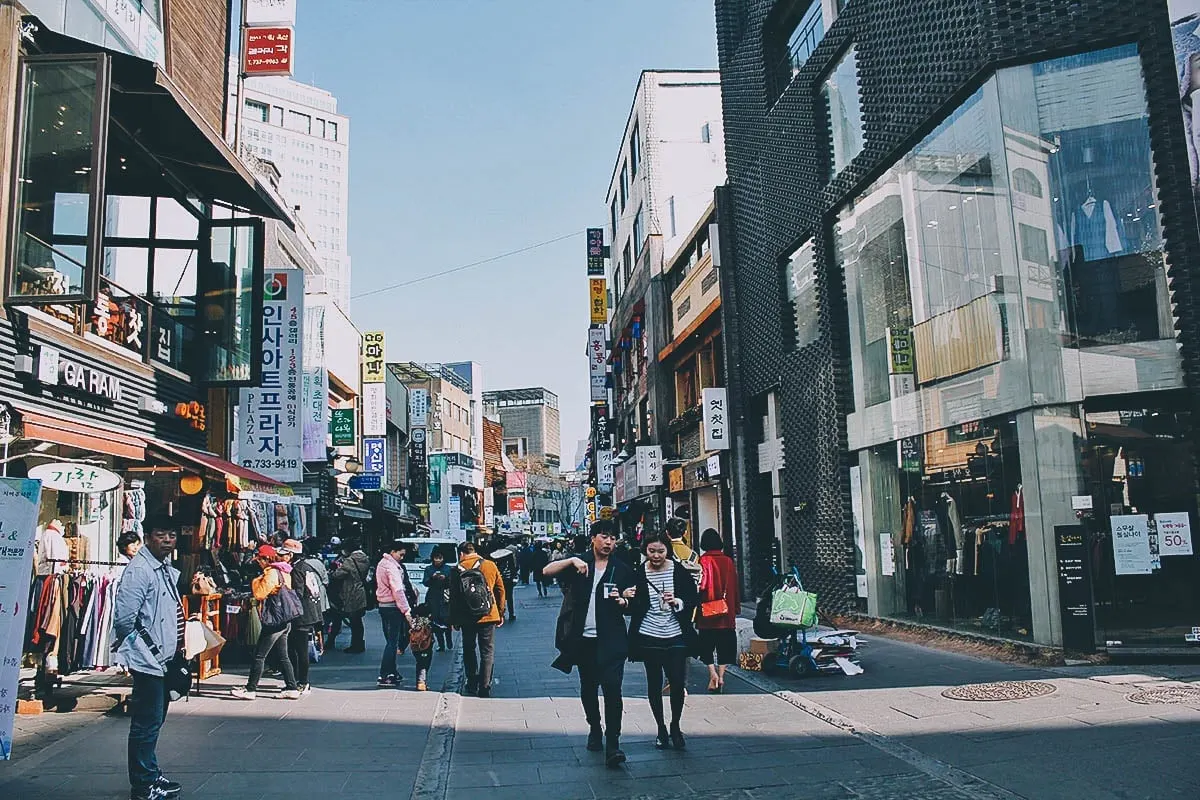
4. Gwangjang Market
If you enjoy visiting traditional markets, then you need to add Gwangjang Market to your Seoul itinerary. It’s a centuries-old market that looks very much like a time capsule. With its many stalls offering Korean favorites like bindaetteok and kimbap, it’s one of the best places in Seoul to have a street food breakfast or snack.
Gwangjang Market is best experienced early in the morning so make this your first stop. If mung bean pancakes aren’t exciting enough for you, then perhaps you can have sannakji for breakfast instead. It refers to that notorious Korean dish of “live” octopus sashimi.
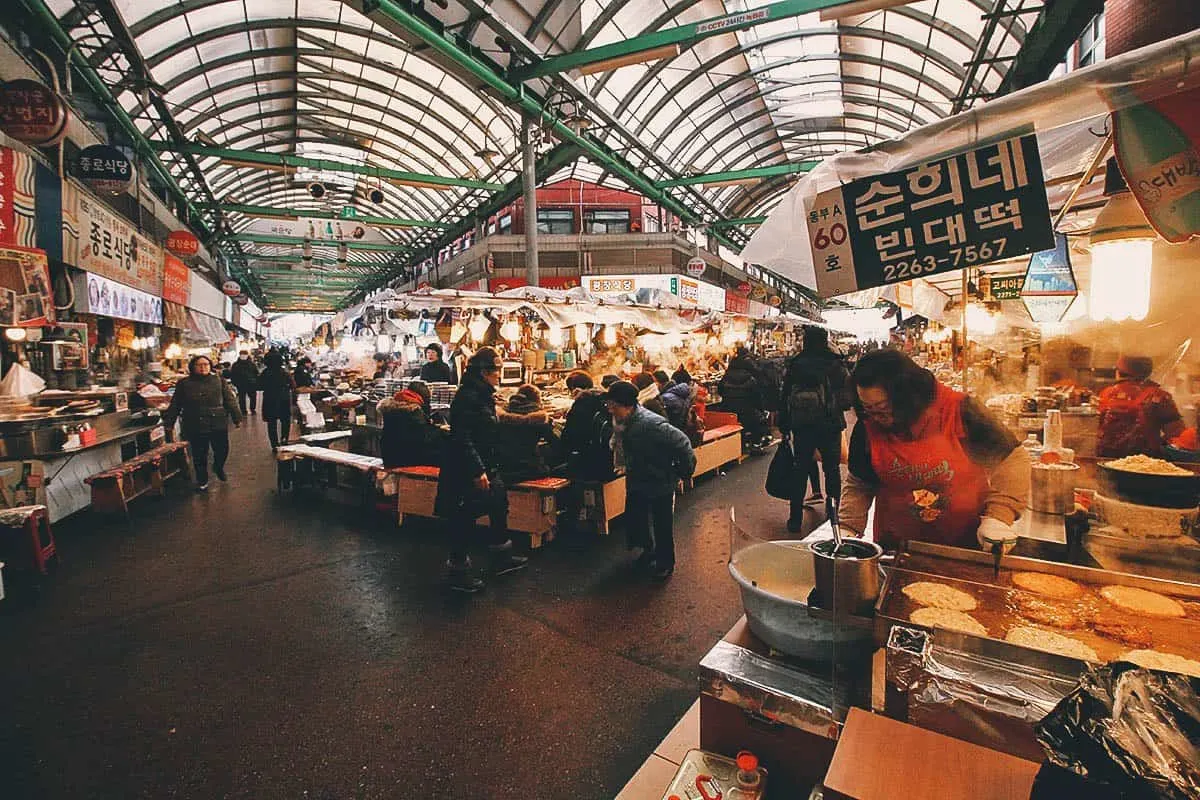
5. Namdaemun Market
Namdaemun Market is another traditional market that you need to visit in Seoul. Unlike Gwangjang Market which offers mostly food, Namdaemun Market is a much larger marketplace offering everything from clothing, souvenirs, toys, kitchenware, flowers, and home accessories.
Of course, you’ll find lots of Korean street food there as well. On our last visit, we stuffed our faces with hotteok and different types of mandu.
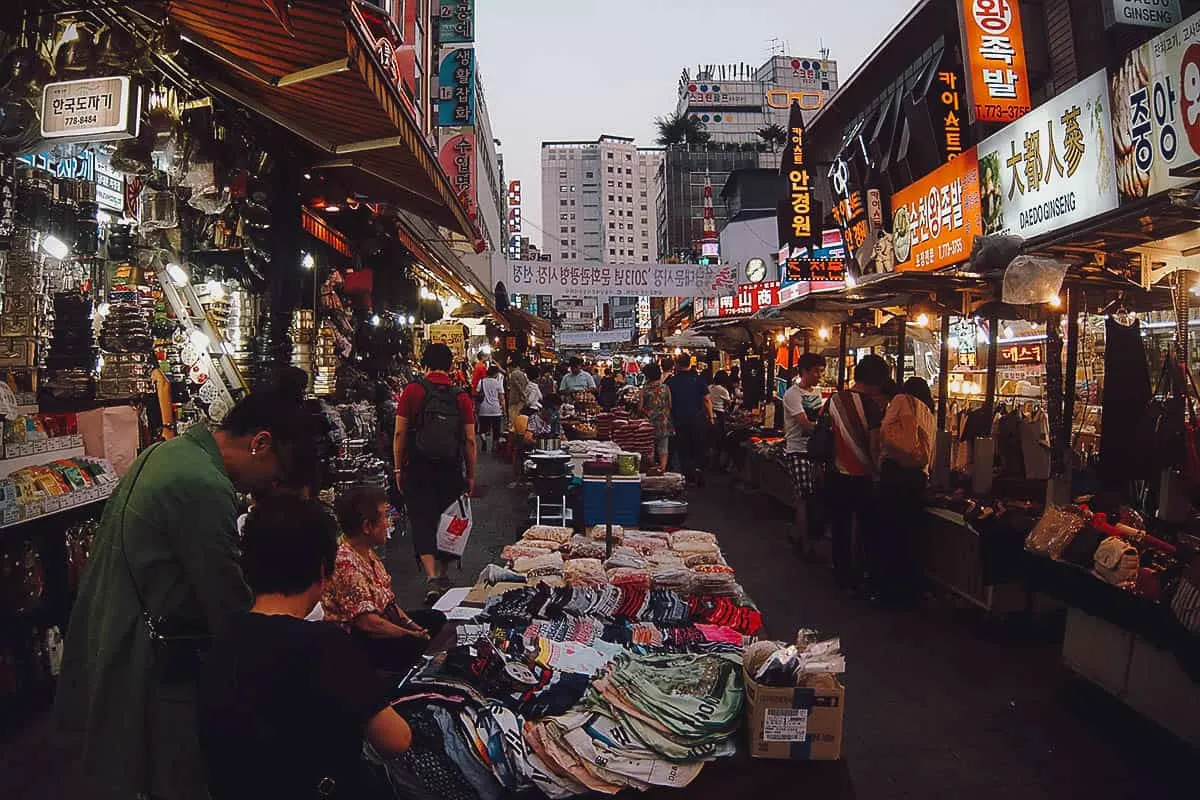
“Namdaemun Market” by Adrián Pérez, used under CC BY-SA 2.0 / Processed in Photoshop and Lightroom
6. Noryangjin Market
Noryangjin Market is one of the largest and most famous live seafood markets in Seoul. We went there to indulge in seafood but I read that a cluster of street food vendors can be found around Exit 1 of the Noryangjin metro station. It gets crowded around lunchtime with students looking to fill up on cheap but delicious street food.
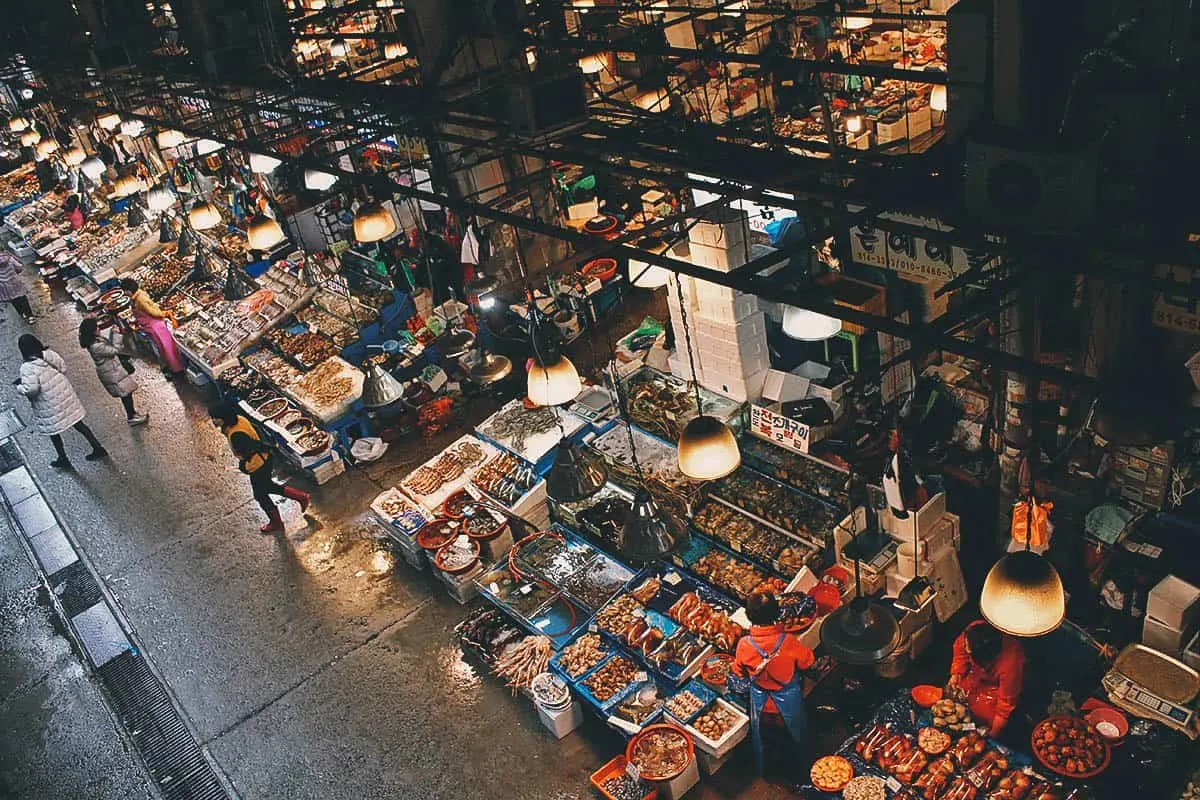
OTHER CITIES IN SOUTH KOREA
7. Bupyeong Kkangtong Market (Busan)
Busan is perhaps the second most internationally famous city in South Korea, after Seoul. Located in the southeastern part of the country, it’s a coastal city that boasts an abundance of fresh seafood and other interesting dishes like dongnae pajeon (Korean savory pancake), milmyeon (buckwheat noodle soup), and dwaeji gukbap (pork soup).
For the most memorable street food experience, head over to Bupyeong Market. It’s famous for its special fish cakes made from crushed and deep-fried fish fillets.
8. Jeonju Hanok Village (Jeonju)
Hanok villages are among the most atmospheric places in South Korea. They refer to residential neighborhoods filled with hanoks or traditional Korean houses. If you’re planning on renting a hanbok (traditional Korean dress) to spruce up your Instagram feed, then a hanok village makes for an ideal backdrop.
In Seoul, Bukchon hanok village is the most popular. In the western city of Jeonju, it’s Jeonju hanok village. Aside from its lovely traditional houses, Jeonju hanok village is also famous for its bibimbap (Korean rice dish) and bibimbap-inspired street food dishes like bibimbbang, bibimbap croquettes, and bibimbap waffles.
KOREAN STREET FOOD TOURS
Eating your way through South Korea is easy but if you’d like to learn more about Korean cuisine, then perhaps you’d be interested in joining a food tour. Simply put, no one knows Korean street food better than a Korean, so who better to guide you through Korea’s best markets than a knowledgeable local?
Check out Get Your Guide for a list of food tours in Seoul and in other cities throughout South Korea.
FINAL THOUGHTS ON KOREAN STREET FOOD
South Korea is booming. Thanks to the global success of K-pop and Korean cinema, people the world over know about BTS and Crash Landing on You. Do you know anyone who hasn’t seen Squid Game?
The growing popularity of K-Dramas shines the spotlight on Korean culture – on its traditions, its social issues, and best of all, on its food.
If you’ve enjoyed watching your favorite Korean actors confess their feelings at pojangmachas, then I hope this article on the most popular Korean street food gets you even more excited to visit Seoul and South Korea.
Disclosure
Some of the links in this Korean street food guide are affiliate links. We’ll get a small commission if you make a purchase at no additional cost to you. We only recommend products and services that we use ourselves and firmly believe in. We really appreciate your support as it helps us make more of these free travel guides. Thank you!
Cover photo by mnimage. Stock photos via Shutterstock.

